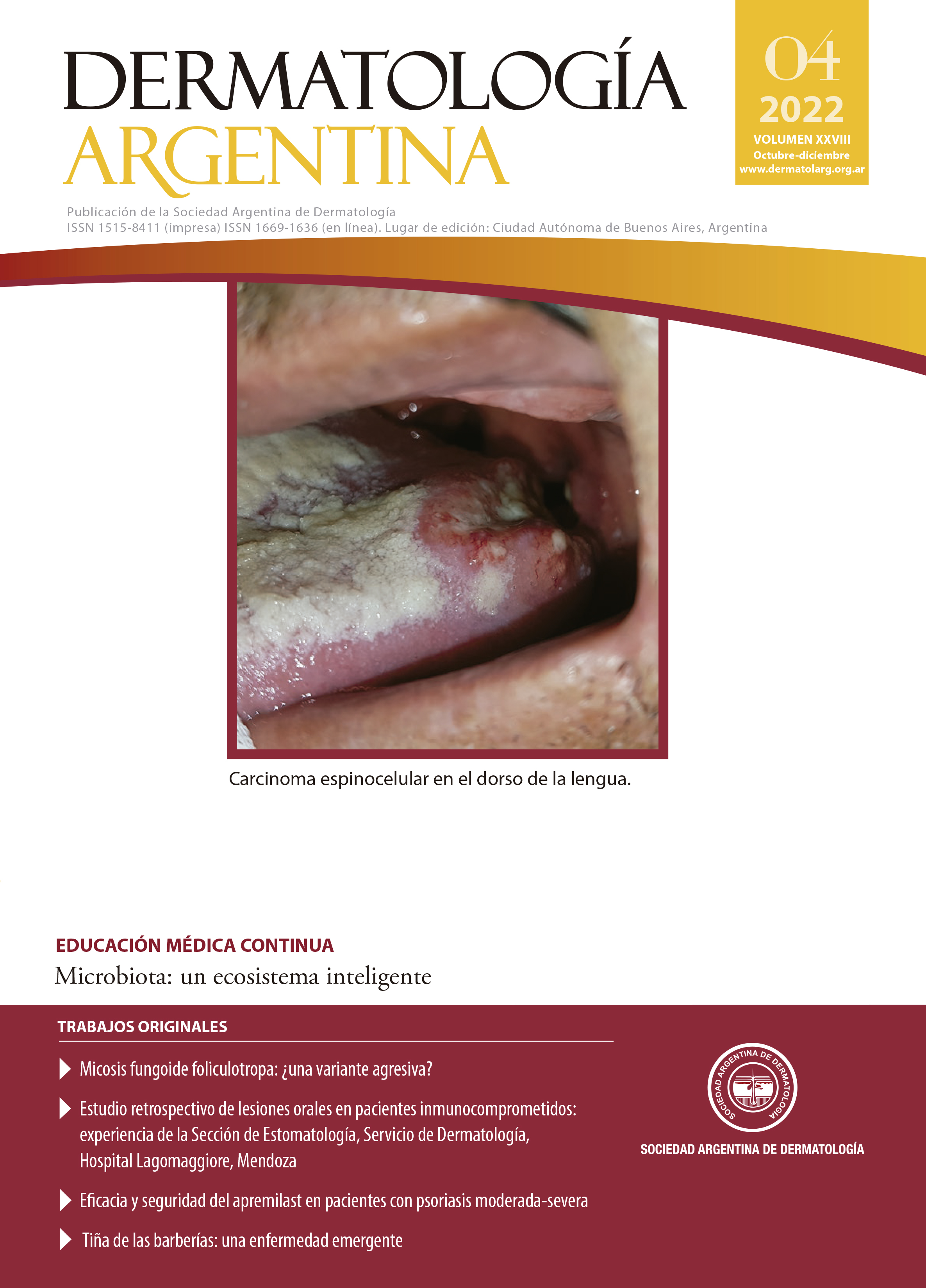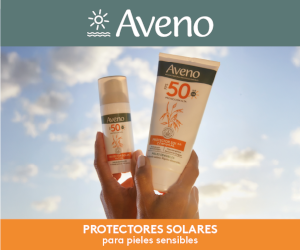Folliculotropic mycosis fungoides: an aggressive variant?
DOI:
https://doi.org/10.47196/da.v28i4.2330Keywords:
mycosis fungoides, folliculotropismAbstract
Background: folliculotropic mycosis fungoides (FMF) is considered an aggressive variant that is refractory to treatment due to the presence of folliculotropism in the histopathology. However, recent publications suggest the existence of a subgroup with favorable prognosis and highlight the importance of the histopathological criteria in patients with plaques.
Objectives: to perform an analysis of patients with FMF and evaluate survival in order to look for the existence of a subgroup with favorable prognosis.
Methods: a retrospective study including patients diagnosed with classic MF and FMF between January 2000 and February 2022 at dermatology service of Hospital Argerich. All patients were classified in two groups: early and advance disease. In patients with FMF and plaques the histopathology criteria were considered for staging.
Results: among 50 patients with FMF, 15 presented and early stage while 28 were classified as advanced stage (IIB or more). The remaining 7 patients (14%) were excluded from the staging due to lack of histopathological data.
Overall survival among patients with FMF was 71% at 5 years and in the classic MF group it was 95%. However, it was observed that survival in early stages of FMF was similar to that in early stages of classic MF.
Conclusions: FMF represented the most frequent variant of MF. Regarding survival, this study demonstrates the existence of a subgroup with favorable prognosis. The histological analysis in the group of plaques allowed a better evaluation of survival.
References
I. Abeldaño A, Enz P, Acosta A, Alperovich M, et ál. Consenso linfomas cutáneos primarios. Soc Argen Dermatol. 2019;1:2-10.
II. Willemze R, Jaffe ES, Burg G, Cerroni L, et ál .WHO-EORTC classification for cutaneous lymphomas. Blood. 2005;105:3768-3785.
III. Abeldaño A, Enz P, Maskin M, Cervini A, et ál. Primary cutaneous lymphoma in Argentina: a report of a nationwide study of 416 patients. Int J Dermatol. 2019;58:449-455.
IV. Willemze R, Cerroni L, Kempf W, Berti E, et ál. The 2018 update of the WHO-EORTC classification for primary cutaneous lymphomas. Blood. 2019;133:1703-1714.
V. Van Doorn R, Van Haselen CW, Van Voorst Vader PC, Geerts ML. Mycosis fungoides disease evolution and prognosis of 309 Dutch patients. Arch Dermatol. 2000;136:504-510.
VI. Abeldaño A, Arias M, Ochoa K, Benedetti A et ál. Micosis fungoide más allá de la forma clásica de Alibert-Bazin: comunicación de diecisiete variantes atípicas. Dermatol Argent. 2008;14:124-133.
VII. Van Doorn R, Scheffer E, Willemze R. Follicular mycosis fungoides, a distinct disease entity with or without associated follicular mucinosis. Arch Dermatol. 2002;138:191-198.
VIII. Gerami P, Rosen S, Kuzel T, Boone SL, et ál. Folliculotropic mycosis fungoides: an aggressive variant of cutaneous T-Cell lymphoma. Arch Dermatol. 2008;144:738-746.
IX. Agar NS, Wedgeworth E, Crichton S, Mitchell T, et ál. Survival outcomes and prognostic factors in mycosis fungoides/Sézary syndrome: Validation of the revised International Society for Cutaneous Lymphomas/European Organisation for Research and Treatment of Cancer staging proposal. J Clin Oncol. 2010;28:4730-4739.
X. Wieser I, Wang C, Alberti-Violetti S, Lyons G, et ál. Clinical characteristics, risk factors and long-term outcome of 114 patients with folliculotropic mycosis fungoides. Arch Dermatol Res. 2017;309:453-459.
XI. Klemke C, Dippel E, Assaf C,Hummel M, et ál. Follicular mycosis fungoides. Br J Dermatol. 1999;141:37-140.
XII. Pisauri AM, Arias M, Abeldaño A. Factores pronósticos en micosis fungoide. Dermatol Argent. 2015;16-30.
XIII. Lehman JS, Cook-Norris RH, Weed BR,Weenig R, et ál. Folliculotropic mycosis fungoides: single-center study and systematic review. Arch Dermatol. 2010;146:607-613.
XIV. Cerroni L. Pilotropic Mycosis Fungoides: A clinicopathologic variant of mycosis fungoides yet to be completely understood. Arch Dermatol. 2010;146:662-664.
XV. van Santen S, van Doorn R, Neelis KJ, Daniels L, et ál. Recommendations for treatment in folliculotropic mycosis fungoides: report of the Dutch Cutaneous Lymphoma Group. Br J Dermatol. 2017;177:223-228.
XVI. Hodak E, Amitay-Laish I, AtzmonyL, Prag-Naveh H, et ál. New insights into folliculotropic mycosis fungoides (FMF): A single-center experience. J Am Acad Dermatol. 2016:347-355.
XVII. van Santen S, Roach REJ, van Doorn R, Horvath B, et ál. Clinical staging and prognostic factors in Folliculotropic Mycosis Fungoides. JAMA Dermatol. 2016;152:992-1000.
XVIII. Charli-Joseph Y, Kashani-Sabet M, McCalmont TH, Kornak J, et ál. Association of a Proposed New Staging System for Folliculotropic Mycosis Fungoides with Prognostic Variables in a US Cohort. JAMA Dermatol. 2021;157:157-165.
XIX. Hodak E, Amitay-Laish I. Mycosis fungoides: A great imitator. Clin Dermatol. 2019;37:255-267.
XX. Mantaka P, Helsing P, Gjersvik P, Bassarova A, et ál. Clinical and histopathological features of folliculotropic mycosis fungoides: anorwegian patient series. Acta Derm Venereol. 2013;93:325-329.
XXI. Flaig M, Cerroni L, Schuhmann K, Bertsch H, et ál. Follicular mycosis fungoides. A histopathologic analysis of nine cases. J Cutan Pathol. 2001;28:525-530.
XXII. Diamandidou E, Colome-Grimmer M, Fayad L, Duvic M, et ál. Transformation of Mycosis Fungoides/Sezary Syndrome: Clinical Characteristics and Prognosis. Blood. 1998;92:1150-1159.
XXIII. Arulogun SO, Prince HM, Ng J, Lade S, et ál. Long-term outcomes of patients with advanced-stage cutaneous T-cell lymphoma and large cell transformation. Blood. 2008;112:3082-3087.
Downloads
Published
Issue
Section
License
Copyright (c) 2022 on behalf of the authors. Reproduction rights: Argentine Society of Dermatology.

This work is licensed under a Creative Commons Attribution-NonCommercial-NoDerivatives 4.0 International License.
El/los autor/es tranfieren todos los derechos de autor del manuscrito arriba mencionado a Dermatología Argentina en el caso de que el trabajo sea publicado. El/los autor/es declaran que el artículo es original, que no infringe ningún derecho de propiedad intelectual u otros derechos de terceros, que no se encuentra bajo consideración de otra revista y que no ha sido previamente publicado.
Le solicitamos haga click aquí para imprimir, firmar y enviar por correo postal la transferencia de los derechos de autor













